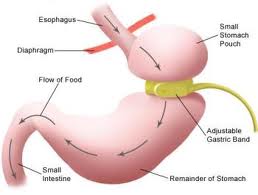How does a gastric band REALLY work?

I have found that sadly there are a lot of misconceptions around gastric bands. Firstly, there is a misconception that the gastric band creates a small stomach that must be ‘filled’ to feel full. There is also a misconception that a tighter band will result in more weight loss and that the vomitting or regurgitation caused by a tight gastric band is ‘normal’. Another misconception is that you shouldn’t be able to eat certain foods with a gastric band.
Let’s get back to basics to understand how a gastric band should work. A gastric band is a silicone device placed around the upper part of the stomach. It was once believed that the gastric band created a new, smaller stomach above the band, where food would sit before passing into the lower, larger stomach. Recent studies at the Centre for Obesity Research and Education (CORE) in Melbourne have shown this to be incorrect.
The gastric band actually creates a ‘funnel’ into the larger stomach and exerts pressure on the stomach. Adjusting the gastric band can vary this pressure. The band has an access point called a port, which is stitched to your abdominal muscle deep under the skin. You can usually tell where the port may be as it is likely to sit somewhere under your biggest scar. Your surgeon or weight loss GP uses the port to adjust your gastric band and vary the pressure it places on the stomach. They can inject or remove saline (a salty water) solution via the port to make your band tighter or looser.
When food is eaten our oesophagus, or food pipe, squeezes bites of food down towards the band. Once food reaches the band, contractions of the oesophagus, called peristalsis, will squeeze well-chewed food past the band. In a person with a well-adjusted band, it can take between two to six squeezes of the oesophagus to get a bite of food across the band. One study suggests this process takes at least a minute.
There are nerves in the stomach that detect when our stomach is stretching, and send a message to our brain that we have had enough to eat. One particular nerve involved in controlling our stomach is called the vagus nerve. With a gastric band sitting around the stomach this squeezes the vagus nerve all the time, and more so when you are eating.
The squeezing process triggers a signal to the brain that you are satisfied, or no longer hungry. This means you feel satisfied on a smaller amount of food than you would have prior to surgery. The constant pressure of the band on the stomach also helps you to feel satisfied for a longer period of time, reducing hunger throughout the day.
Feeling satisfied is different to feeling ‘full’. Feeling ‘full’ means you have eaten to excess. It may indicate food is sitting above the band, either due to eating too quickly, eating large pieces of food or not chewing food well enough. Try to stop eating when you feel satisfied or no longer hungry, rather than full.
Each bite of food must be small and well chewed. An empty, or uninflated band has an opening the size of a twenty-cent piece. A fully inflated band has an opening the size of a five-cent piece. Most people will have their band adjusted somewhere between the two sizes. If you cut food into the size of a five-cent piece size and chew it well, it is more likely to pass comfortably through the band.
Eating slowly also helps you to eat comfortably. In theory, you should aim to wait a minute between each mouthful of food, however it is not practical to time every mouthful. It is practical to put your cutlery down between mouthfuls and wait until you have swallowed before cutting the next piece of food ready to eat. People with a gastric band who eat quickly, describe a feeling of discomfort in their oesophagus, like a ‘traffic jam’. Eating slowly will help avoid this.
I hope this clarifies how a gastric band works and what you should experience. If your band is not acting like it should, please follow up with your support team.
Great article but we don't have 20 cent pieces here in the states and a 5 cent piece is a nickel here and is bigger than I would think the hole would be? Can you think of something more universal? Marbles? Pencil diameter? 10 millimeters ID?
So, I looked up 5 and 20 cent AU diameters. For we here in the states, that equates to approximately 3/4 in diameter filled, to 1 1/8 in unfilled. Can we assume you mean the band itself has an opening the size of 5-20 depending on how filled it is? But, to visualize this would also mean we have to include the thickness of our own stomach lining which will be different for all of us? Folds within the stoma also complicate the equation? Stomach lining thickness must equal about 5-10 millimeters which would leave the stoma on an unfilled band at approximately 2/3 inch. Not a lot of room for food to pass is it? Sorry for over analyzing this but I like to have a mental picture of what the heck is going on down there.
Hi 2muchfun,
Thanks for your comments. Yes, it is correct that the thickness of our stomach lining and folds within the stoma would complicate things. The only real way to see what exactly is happening in each individual would be to have an endoscopy. My overall point is to try and give a guide that yes, there is not much of an opening for food to get through and that is why we need to take a lot of care when eating. Cut food small, chew well, eat slowly, etc. As an aside, looking at your ticker however I see you are doing well - 50lb lost - great work!
Sally
Thank you for the information wow
What's the size for someone not banded? Just for comparison.
Hi Tara-U,
Good question and one best for a doctor or surgeon.
The important point is that our oesophagus and stomach can stretch to accomodate lumps of food, a band cannot stretch in this way.
Sally
I guess lots of people here never received all this information from their doctor's office before surgery. I actually have a Allergan Omiform 14cc proto-type lapband here at home. My sister works for Allergan and i was able to read clinical studies on the band and what it truly does.
Thanks for the insight.
I agree they did not give me much info before surgery ,just asked me do I want lapband or bypass! I was nervous to do the bypass because of loss of Vitamins. They gave me the Allergan lapband Ap large because when they were doing surgery they found a hernia so they gave me a large band not standard due to swelling after. I get nervous thinking that the band may slip!! easy!!,and get pain by my port some times ,does any one else have pain by the port?








can_do 195
Posted
I'm SO happy to see this information posted. Most people, including those that are banded DON'T understand how a band really works. Thank you for bringing this to light.
Share this comment
Link to comment
Share on other sites